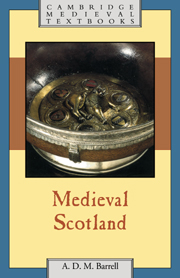Book contents
- Frontmatter
- Contents
- List of figures
- Preface
- List of abbreviations
- Maps
- 1 Early medieval Scotland
- 2 Feudal Scotland
- 3 The transformation of the Scottish church
- 4 The consolidation of the Scottish realm
- 5 The Wars of Independence
- 6 The Stewart kings
- 7 Crown and nobility in later medieval Scotland
- 8 The road to Reformation
- Conclusion
- Select bibliography
- Index
- Title in the Series
8 - The road to Reformation
Published online by Cambridge University Press: 05 June 2012
- Frontmatter
- Contents
- List of figures
- Preface
- List of abbreviations
- Maps
- 1 Early medieval Scotland
- 2 Feudal Scotland
- 3 The transformation of the Scottish church
- 4 The consolidation of the Scottish realm
- 5 The Wars of Independence
- 6 The Stewart kings
- 7 Crown and nobility in later medieval Scotland
- 8 The road to Reformation
- Conclusion
- Select bibliography
- Index
- Title in the Series
Summary
The dramatic events of the Protestant Reformation have tended to cast a long shadow over the preceding centuries, and as a result the failings of the late medieval church have often been emphasised at the expense of its virtues. This is perhaps especially true of Scotland, both because of the virulence of many early Protestant commentators such as John Knox, and as a result of the paucity of evidence about religious practice in pre-Reformation Scotland which might be set against the much more abundant material relating to the institutional aspects of the church. It is a straightforward matter to discover examples of scandalous promotions and avaricious clerics holding several benefices, note the decline in the ideals of monasticism, and dismiss as half-hearted the attempts at reform by the hierarchy in the 1550s. This approach, needless to say, presents only part of the picture, and implies that the Scottish church was so debased by the middle of the sixteenth century that it required drastic, not piecemeal, reform. Such reform was hampered, it might be argued, by Scotland's adherence to the corrupt and venal Renaissance papacy.
This chapter examines the late medieval church in Scotland from a number of standpoints, investigating the impact of the papacy on ecclesiastical patronage, relations between the popes and Scottish kings at a diplomatic level, the undoubted abuses of pluralism and non-residence and the breakdown of monastic life, the evidence for continued vibrancy, particularly in the context of popular religious practice and a growing interest in native Scottish saints, and the incidence of heresy in Scotland.
- Type
- Chapter
- Information
- Medieval Scotland , pp. 228 - 262Publisher: Cambridge University PressPrint publication year: 2000



